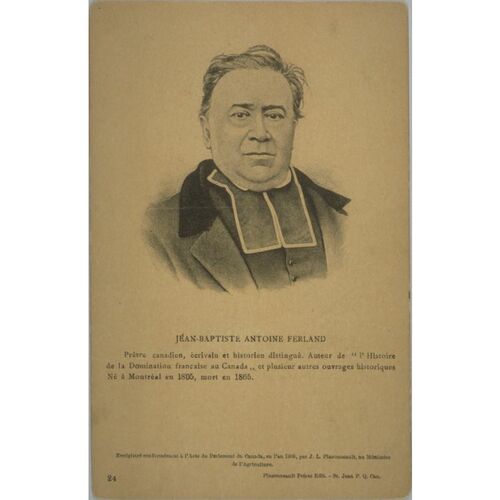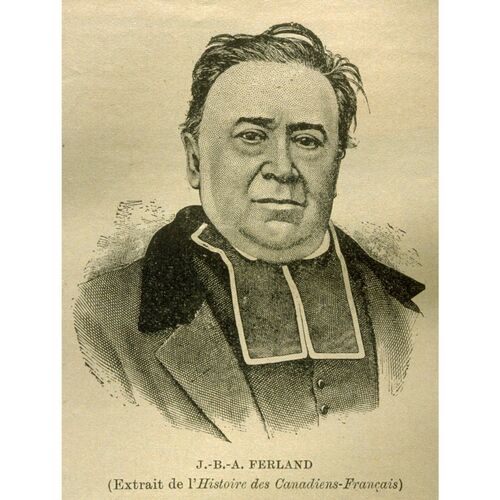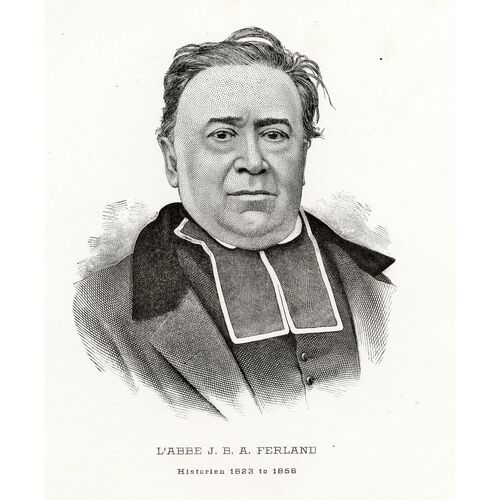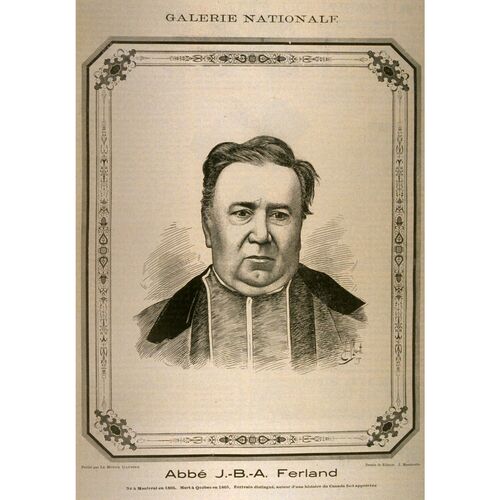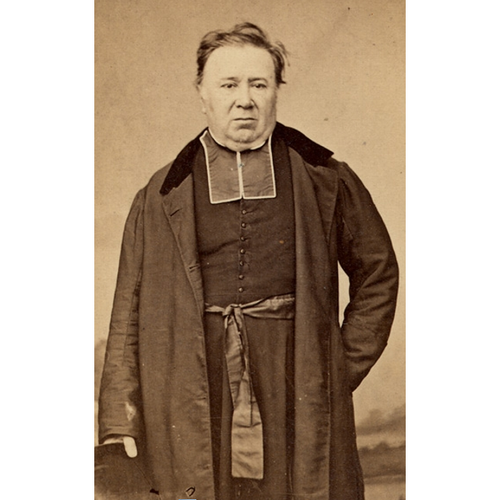FERLAND, JEAN-BAPTISTE-ANTOINE, priest, professor, and historian; b. 25 Dec. 1805 at Montreal, Lower Canada, son of Antoine Ferland, a merchant, and Élizabeth Lebrun de Duplessis; d. 11 Jan. 1865 at Quebec.
Little is known about Jean-Baptiste-Antoine Ferland’s paternal ancestry. His father, who was born at Saint-Pierre, he d’Orléans, died before Jean-Baptiste-Antoine’s birth. Thus, when he became a priest, Jean-Baptiste-Antoine was for a long time the financial support of his mother. She was the daughter of Jean-Baptiste Lebrun* de Duplessis, who had arrived in Canada in 1755 as a volunteer in the French armed forces. At the beginning of the English régime, Jean-Baptiste-Antoine’s grandfather, and godfather, had formed a friendship with Francis Maseres*, who was attorney general of the Province of Quebec from 1766 to 1769 and whose political views he shared. In 1778 Maseres wrote to him: “I do not know if you have learned English, but a man of your intelligence and talent ought to have done so.” It does seem that, by his maternal ancestry at least, Ferland belonged to a family that had been converted to “bilingualism” from the beginning of the English régime. He learned English as a boy and when he was only eight years old his mother moved to Kingston, Upper Canada. There he met his cousin Julia Catherine Beckwith, whose novel St. Ursula’s convent, or the nun of Canada, containing scenes from real life, would be published in 1824; he was to correspond with her during his studies at the Collège de Nicolet.
In 1816, through the influence of Abbé Rémi Gaulin*, a missionary in Upper Canada and later bishop of Kingston, Ferland entered the Collège de Nicolet, where, as the protégé of Bishop Joseph-Octave Plessis* (whose biography he later published), he achieved a brilliant record in classical studies: in 1821 he was first in the philosophy class. In 1822 he chose the ministry, and the following year, still only a candidate for the priesthood, he became Bishop Plessis’s temporary secretary. In 1828 Ferland was ordained priest at the age of 22, not an unusual age at this period when the shortage of priests encouraged early ordinations.
On 14 September, the day of his ordination, Abbé Ferland was appointed curate of the Quebec parish of Notre-Dame (1828–29). He then served as curate at Fraserville (Rivière-du-Loup) and at Saint-Roch in Quebec, and in 1834 became first chaplain of the Marine and Emigrant Hospital at Quebec. From 1834 to 1841 he was successively parish priest of Saint-Isidore (near Lévis), Sainte-Foy, and finally Sainte-Anne-de-Beaupré. In 1836 he accompanied Bishop Pierre-Flavien Turgeon, then coadjutor to the archbishop of Quebec, on his visit to the Gaspé; 25 years later Ferland published an account of this trip. Because of his knowledge of English, Ferland was often called upon during his years as a parish priest to minister to Anglo-Catholic minorities. The devoted attention he gave to Irish immigrants on Grosse Île, stricken with typhus in 1847 [see George Mellis Douglas], earned him great respect among the Irish community of Quebec.
In 1841 Abbé Ferland returned to the Collège de Nicolet, where he remained nine years. He was professor of literature, history, and philosophy, and rose through the administrative hierarchy of the institution, becoming dean of studies (1841–50), director (1842–48), and superior (1848–50). The intellectual curiosity of a future historian developed in these years, during which he also took up botany. He was interested in social and political questions, and read the Mélanges religieux and the Quebec Gazette to some of his students; they took notes in English to familiarize themselves with the second language. Encouraged by the episcopacy, Abbé Ferland devoted himself particularly to historical studies, and in 1842 supported and sponsored the founding at the college of a literary society, where subjects drawn from national history were discussed.
At the end of the 1840s the college faced financial difficulties, due in large part to scarcity of students. The deficits were such that there was talk of selling the building to the state for conversion into a penitentiary. Abbé Ferland, who was then superior, quietly informed his bishop that if the difficulties appeared to have been caused by his own bad administration, he would gladly leave the college. To increase the number of boarders, he asserted, they should perhaps think of imitating the Collège de L’Assomption and the Collège de Saint-Hyacinthe, which allowed their students to take meals outside the institution. Meanwhile the deficit persisted, and at the beginning of term in September 1849 there were only 70 boarders. Ferland attributed this drop to the scarcity of money in circulation. In December of that year the superior voiced to Bishop Turgeon his anxiety over the college’s financial situation, since the amounts receivable from boarders’ fees for the previous two years totalled only £600. Claiming that he was ill-suited to administration, he hoped that he might be appointed a parish priest. To his more intimate friend Abbé Louis-Jacques Casault, Ferland gave a somewhat different version. He had already confided to Casault in 1847 that he had joined the staff of the college against his wishes. He called himself a victim of “vexations . . . aimed at the office [of superior] and not at the person.” The refusal to take financial aid from the government, which other similar institutions accepted at the time, was in his eyes the determining cause of the inglorious state of Nicolet.
Ferland resigned his post as superior during the summer of 1850, and then divided his time between research, teaching, and a number of administrative and pastoral tasks. He lived at Quebec as he was counsellor to the archdiocese. He was appointed treasurer of the Society for the Propagation of the Faith and drew up its annual report. In 1852 he visited Anticosti Island (where he heard the legend of the sorcerer Gamache). In 1855 he was appointed military chaplain in the episcopal city. Then in 1858, at the request of Bishop Charles-François Baillargeon, the archdiocesan administrator, he visited the Catholic population settled on the Labrador coast, and assisted the Oblate François Coopman at Mécatina.
It was during the 1850s that Abbé Ferland’s career as an historian took shape. In 1854 he had been appointed a professor at Université Laval in the faculty of arts (of which he became dean in 1864), and was assigned a course of public lectures on the history of Canada. This task made it necessary for him to visit archival collections in Europe in 1856–57, one of his concerns being the transcription of documents. Indeed, the Séminaire de Québec had undertaken to pay half the expenses of his trip to France, on condition that he obtain copies of “all that he deems of interest concerning America and Canada in particular.” For several years after his return his public lectures attracted an audience whose actual size and composition are difficult to specify. However, it seems that this stocky, stout little man, intelligent and lively if not particularly eloquent, drew fair-sized crowds. According to Antoine Gérin-Lajoie*, a pupil of Ferland’s at Nicolet, his lecture on the years of the Conquest was delivered before a gathering of 300 to 400 persons. The lecture series, which Ferland would have liked to extend to the constitutional régime, was published in two volumes in 1861 and 1865. However, his premature death prevented him from supervising the printing of the second, which stopped at the Conquest. At his death Jean-Baptiste-Antoine Ferland left a library of modest proportions, as well as a small sum saved for his old age; these he bequeathed to the Asile du Bon-Pasteur at Quebec, where he was chaplain from 1853 to 1856.
The beginning of Ferland’s literary vocation is usually traced to the publication in 1852 of Histoire du Canada, de son Église et de ses missions depuis la découverte de l’Amérique jusqu’a nos jours . . . (Paris), by Charles-Étienne Brasseur* de Bourbourg. Ferland’s Observations sur un ouvrage intitulé “Histoire du Canada,” which was published in 1853 but first appeared in the form of articles in Le Journal de Quebec in January and February of that year, is indeed the first monograph Ferland wrote for which he could familiarize himself with national history. But this work is not itself enough to explain why Abbé Ferland was adopted by the clergy during the 1860s as a spokesman for its interpretation of the past. The voluminous history of Canada by the historian priest has rather to be fitted into the social struggle of the 19th century, in the course of which the clergy emerged victorious over the increasingly marginal élite nurtured on European doctrinal liberalism. During the first half of the 19th century the Catholic clergy in Canada, weak in relation to the bourgeoisie, had been somewhat roughly handled by historians. In the 1840s, 30 years after the anti-clerical and anti-French-Canadian history of William Smith*, François-Xavier Garneau became the defender of liberal values in his interpretation of Canada’s past. A nationalist, his version of the facts could be considered preferable to that of Michel Bibaud*. Garneau’s Histoire du Canada was seen by the French Canadian professional class as a compensation for the defeat of 1837–38. A clerical version of Canada’s history began as early as 1845 with a refutation of Garneau’s interpretation of François de Laval*; two pamphlets devoted to the prelate were published that year, one by Abbé Louis-Édouard Bois*, the other by Abbé Brasseur de Bourbourg. But during the 1850s neither Brasseur de Bourbourg’s synthesis nor Abbé Étienne-Michel Faillon’s works succeeded in creating unanimity within the Catholic clergy. Although Brasseur de Bourbourg’s interpretation was ultramontane, it tended to serve the liberals by freely condemning the action of the episcopate as too timid about “encroachments” by the state. For his part, Faillon had attacked the ecclesiastical dignitaries of Quebec for being unjust towards Montreal. In the 1860s the time seemed to have come to reach unanimity on the historical role of clerics, in order to encourage some sort of consensus about the growing ascendancy of the clergy over the destinies of French Canada. To this task Ferland dedicated his efforts.
His Cours d’histoire du Canada is indeed a reply to the liberals, as well as to the historian priests who wrote too much about the conflicts that had divided the clergy throughout the country’s history. An attentive reader of Ferland’s synthesis is aware of his concern to create an image of an ideological unanimity for churchmen. Any references to the conflicts between church and state that divided the leaders of New France are timid. The Quebec historian assigns a role to the church at Montreal with no hint of the rivalries that had been uncovered by Faillon and that Abbé Henri-Raymond Casgrain*, in his biography of Marie de l’Incarnation [Guyart*] in 1864, also wanted to attenuate. In Ferland’s synthesis, everything unfolds as if the clergy had scarcely ever had to contend with acute problems that brought it into conflict with civil authority. According to him, the people followed the illustrious examples of virtue offered by both lay and religious leaders, trod the path they traced, and conformed to the models of behaviour they proposed. Similarly, the Amerindians obeyed the missionaries, the example of white Christians and the word of the Gospel having sufficed to convince them of the truth of Christianity.
Apart from this central preoccupation to demonstrate the beneficent influence of clergy and Catholicism on colonial society, Ferland succeeded more markedly than any other French Canadian writer in the 19th century in describing the Amerindian civilization without the discriminatory attitude towards the aboriginal races so characteristic of the time. He realized that the Amerindians felt alienated in the presence of Europeans. Hence, he explained, their relentless opposition to the white man. True, Ferland’s Amerindians are cruel and bloody, but, as he said, this was “Indian politics.” To him, their actions were perhaps as valid as those of the settlers, whom he condemns on occasion for misusing force or for lacking frankness and justice in their dealings with the native peoples. We owe to Ferland the condemnation of the kidnappings perpetrated by Jacques Cartier*, the military alliance of Samuel de Champlain* with the Hurons, and the behaviour of Jacques-René de Brisay* de Denonville towards the “enemy” of the whites. The Amerindians’ social organization prompted Ferland to write pages totally missing in traditional French Canadian historical works. When it was fashionable to stress the superstitious nature of indigenous beliefs, Ferland took a close interest in what he called their “theology” and studied the “Indian philosophers.” Amerindian society seems to have favoured strongly a respect for individual liberties, an observation which made it possible for the author to explain why treaties of peace or military alliance, which do not bind individuals, were as a rule little honoured. On the other hand, an ultramontane could not remain neutral when noting the existence of liberalism even among the Amerindian tribes. “Many comparisons could be made,” wrote Ferland, “between the Iroquois confederacy and the federation of the United States. Both founded on the principle of the liberty of man, they have to a great extent adopted its consequences: assemblies of the nation, the state, the commune, frequent councils, numerous stump-orators; independence of men, women, and children; and, in the midst of all these liberties, slavery.” It is not surprising that such a parallel was drawn by an author who had read widely in the history of the United States and who corresponded regularly with the historian John Gilmary Shea.
When it was published Ferland’s Cours d’histoire du Canada was praised by the critics. The work corresponded to the nationalist clerical ideology that was beginning to dominate French Canadian thinking. It was during the 1880s that the conception of history elaborated by the clergy was censured by liberals. In his Histoire des Canadiens français, 1608–1880 . . . , published in eight volumes at Montreal from 1882 to 1884, Benjamin Sulte* disputed certain interpretations of Abbé Ferland. Since the latter’s work was in some ways a story of missionary endeavour, one can readily understand that Sulte’s condemnation of missionary activity must of necessity imply censure of the authors who had extolled it. But the isolated attacks of a few liberal francstireurs were not enough to imperil Ferland’s credibility. In the conservative context of the second half of the 19th century, he was preferred to his adversary. Did not the French liberal Eugène Réveillaud, in his Histoire du Canada et des Canadiens français, de la découverte jusqu’à nos jours, published in Paris in 1884, style Ferland an ultramontane historian? In the last decades of the 19th century, this was sufficient to make him a herald of the whole truth.
[The works of J.-B.-A. Ferland are relatively numerous and have each received at least two editions. Observations sur un ouvrage intitulé “Histoire du Canada,” etc. par M. l’abbé Brasseur de Bourbourg (Québec), which had first appeared in Le Journal de Québec on 22, 25, 29 Jan. and 1 Feb. 1853, appeared in pamphlet form that year and was republished in Paris in 1854. After Notes sur les registres de Notre-Dame de Québec (Québec, 1854; 2e éd., 1863), Ferland published his most important historical work, Cours d’histoire du Canada (2v., Québec, 1861–65). A second edition appeared in 1882, and a third, under the title La France dans l’Amérique du Nord, was published at Tours, France, and Montreal in 1929. Finally, in 1969 an American company reprinted the first edition. In 1863 Le Foyer canadien; recueil littéraire et historique (Québec), I, 70–312, published a long article by Ferland entitled “Notice biographique sur Monseigneur Joseph Octave Plessis, évêque de Québec.” In 1864 T. B. French brought out an English translation of it in book form: Biographical notice of Joseph Octave Plessis, bishop of Quebec (Quebec); in 1878 the work entitled Mgr. Joseph-Octave Plessis, évêque de Québec was published at Quebec.
In the 1860s Ferland published a number of articles that were to have several editions: first a “Journal d’un voyage sur les côtes de la Gaspésie,” which appeared in Les Soirées canadiennes; recueil de littérature nationale (Québec), 1 (1861), 301–476. In 1877 and 1879 reprints of this article were published in book form at Quebec under the title La Gaspésie. Finally, Ferland signed two articles in La Littérature canadienne de 1850 à 1860 (2v., Québec, 1863–64), I: “Louis Olivier Gamache” (pp.259–74), and “Le Labrador” (pp.289–365). These articles were published in 1877 as Louis Gamache, le Labrador, opuscules (Québec). This volume, commonly called Opuscules, was subsequently published in several editions.
Manuscript sources concerning Jean-Baptiste-Antoine Ferland’s life and work are not substantial and often of little interest. Research at the ASQ, the Archives de l’université Laval, and the Séminaire de Nicolet furnished little information; nor did the Ferland papers preserved at the AAQ in the T series. Significant printed sources are also rare, probably because of the dearth of manuscript material. However, literary critics have given a good deal of importance to the literary and historical work of Ferland. For more detail about the studies that proved useful in the writing of Ferland’s biography, the reader is referred to J.-B.-A. Ferland; textes, T.-M. Charland, édit. (Montréal et Paris, 1958). The reader may also find it advantageous to consult the following: Le Monde illustré (Montréal), 30 août 1890; J.-A.-I. Douville, Histoire du collège-séminaire de Nicolet, 1803–1903, avec les listes complètes des directeurs, professeurs et élèves de l’institution (2v., Montréal, 1903), I; and Frère Fernando [Gérard Bédard], “L’abbé Jean-Baptiste-Antoine Ferland; son oeuvre historique et littéraire” (thèse de ma, université de Montréal, 1953). s.g.]
Cite This Article
Serge Gagnon, “FERLAND, JEAN-BAPTISTE-ANTOINE,” in Dictionary of Canadian Biography, vol. 9, University of Toronto/Université Laval, 2003–, accessed January 18, 2026, https://www.biographi.ca/en/bio/ferland_jean_baptiste_antoine_9E.html.
The citation above shows the format for footnotes and endnotes according to the Chicago manual of style (16th edition). Information to be used in other citation formats:
| Permalink: | https://www.biographi.ca/en/bio/ferland_jean_baptiste_antoine_9E.html |
| Author of Article: | Serge Gagnon |
| Title of Article: | FERLAND, JEAN-BAPTISTE-ANTOINE |
| Publication Name: | Dictionary of Canadian Biography, vol. 9 |
| Publisher: | University of Toronto/Université Laval |
| Year of publication: | 1976 |
| Year of revision: | 1976 |
| Access Date: | January 18, 2026 |


![Abbé J.-B.-A. Ferland Né à Montréal en 1805. Mort à Québec en 1865. Écrivain distingué, auteur d'une histoire du Canada fort appréciée / [image fixe] : Edmond-Joseph Massicotte Original title: Abbé J.-B.-A. Ferland Né à Montréal en 1805. Mort à Québec en 1865. Écrivain distingué, auteur d'une histoire du Canada fort appréciée / [image fixe] : Edmond-Joseph Massicotte](/bioimages/w600.3851.jpg)
